COSMO Advanced Materials
Leading the Way to Global Excellence
COSMO Advanced Materials
Leading the Way to Global Excellence
/ Products / Toner
Toner
Toner
COSMO AM&T (formerly Saehan Media) launched its toner business in 1976, building on its magnetic media ventures in video and audio. To support this, the company became the first in Korea to develop magnetic iron oxide in 1987. Leveraging this expertise, COSMO AM&T entered the toner industry in 2004 and has since expanded its production capacity to 1,800 tons annually. Currently, the company supplies color toners to over 60 clients worldwide.
R&D
Since 1987, COSMO AM&T has leveraged its know-how in producing 10,000 tons of magnetic iron oxide annually to develop innovative toner products. Initially focused on magnetic component-based toner, the company now manufactures high-speed non-fused color toner, supplying to over 60 customers globally. Looking ahead, COSMO AM&T plans to focus on high-value-added toner products, while also accelerating R&D in other advanced electronic materials.
Cosmo Toner

COSMO AM&T’s toner division focuses on customer-oriented development, reflecting specific regional demands and expanding design compatibility across various models. With 40 years of core toner technology and quality systems, COSMO TONER continues to listen to its customers and aims to deliver globally top-tier products.
Adoption
Since 1938, when Carlson invented the electrophotographic process utilizing triboelectric charging, electrophotography has become an essential technology in offices worldwide—evolving from analog copiers to digital printers, full-color copiers, and now multifunction devices. As these imaging technologies have advanced, toner technology has also progressed in step.
Toner is a fine powder with a particle size of approximately 6 to 15 micrometers, used in copiers and printers. It plays a crucial role in the electrophotographic process by rendering the invisible electrostatic image formed on the photoconductor into a visible image.
Toner Characteristics
Toner powder is designed with an average particle size of 8μm, offering exceptional uniformity and superior flow characteristics.
Its primary ingredients—resin, magnetite, charge control agents, pigments, and wax—can be precisely blended to tailor color performance and functional attributes.
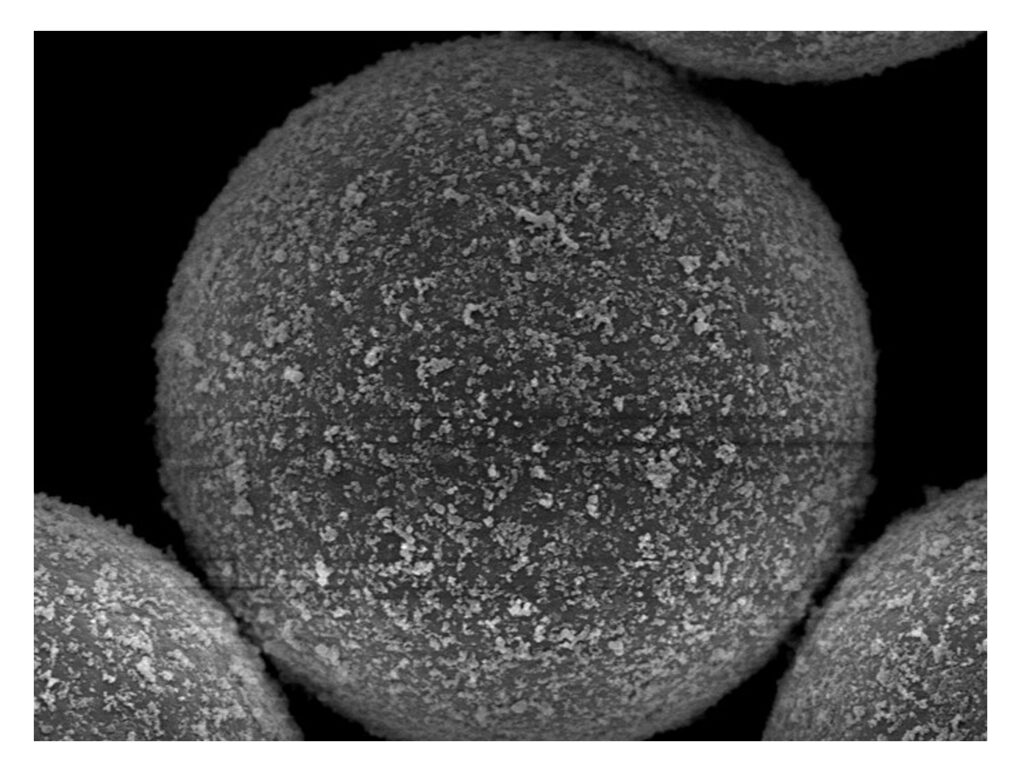
Polymerized Toner

Conventional Toner
Classification of Toners by Manufacturing Method
Classification of Toners by Developing Method
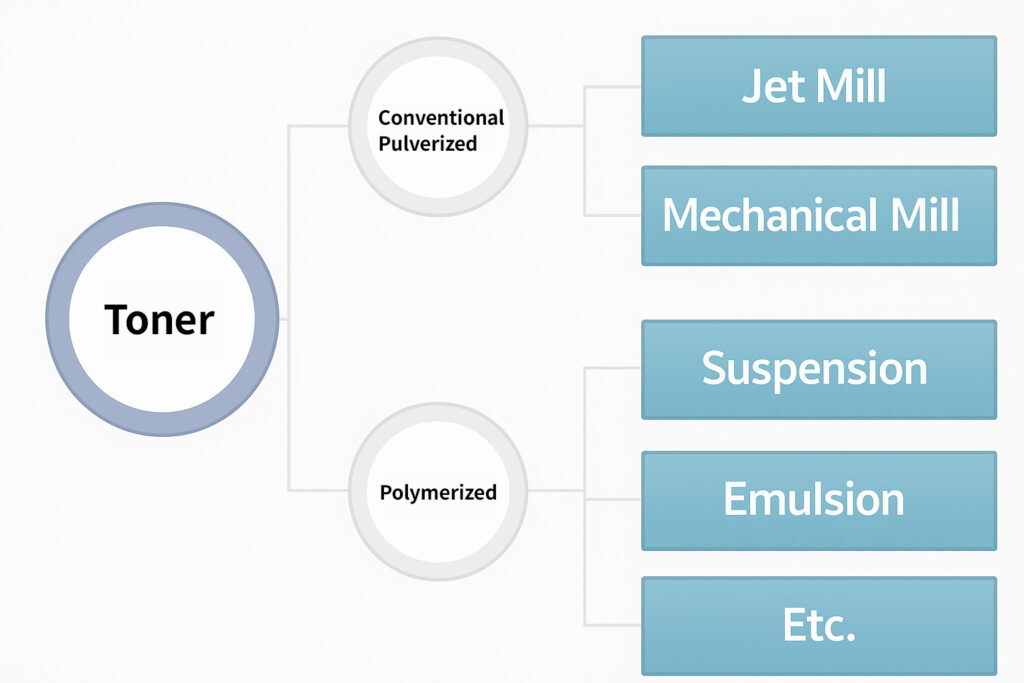
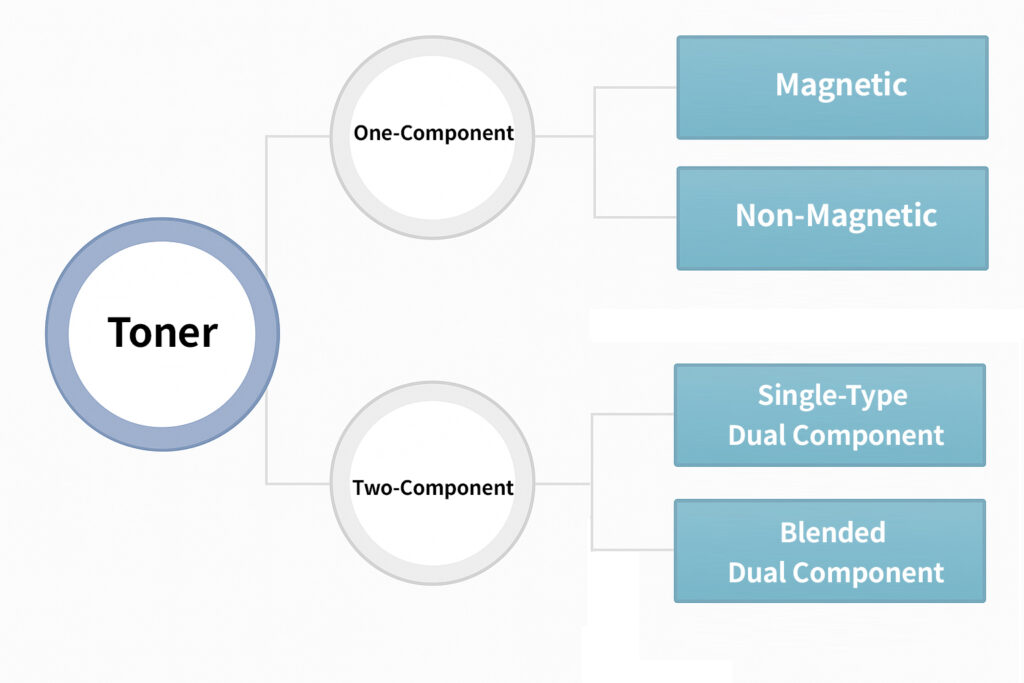
Fundamental Principles of the Electrophotographic Process
The electrophotographic imaging process involves a continuous system of steps: toner charging through corona discharge, creation of an electrostatic latent image via exposure on a charged photoconductor, development of the visible image with toner, image transfer onto paper, and heat-pressure fusion for permanent fixation.
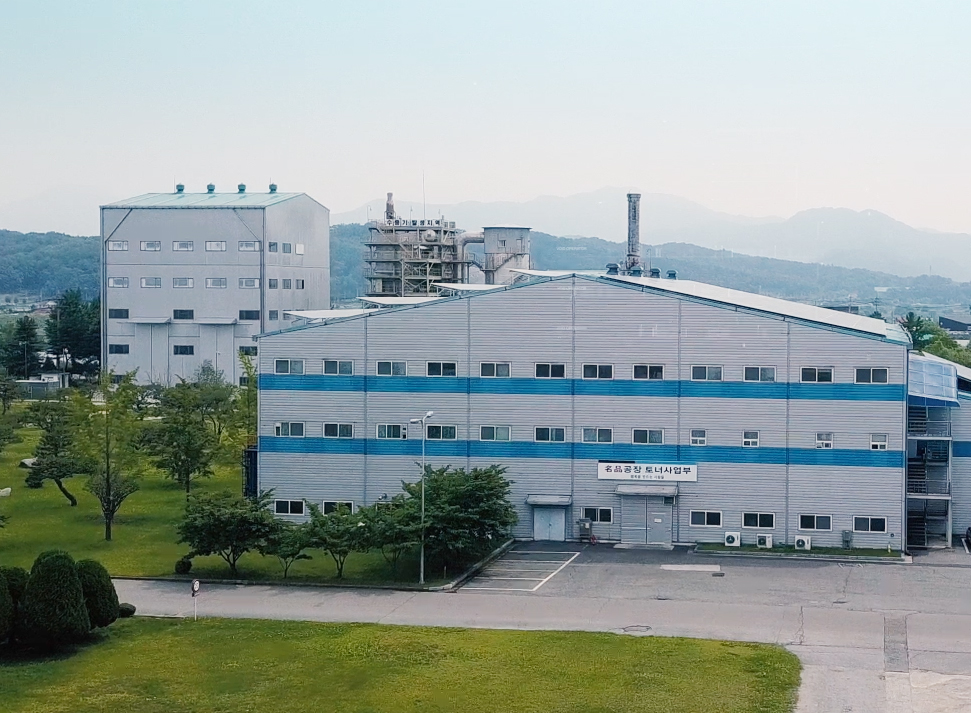
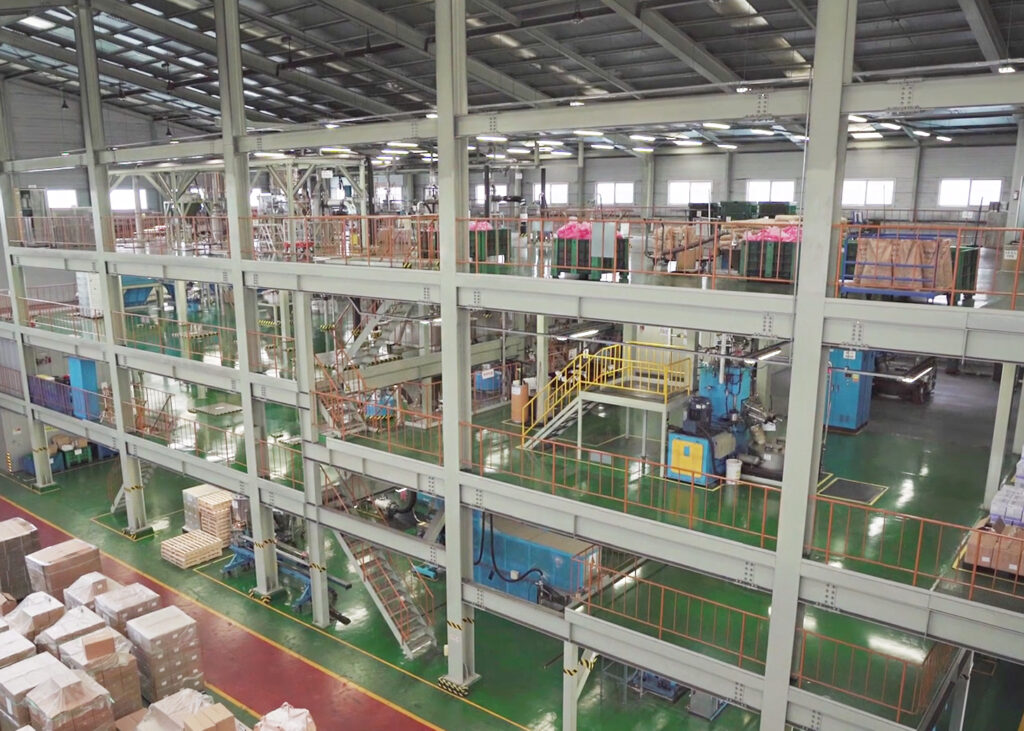
① Charging
A uniform electrostatic charge is applied to the surface of the photoreceptor.
① Charging
A uniform electrostatic charge is applied to the
surface of the photoreceptor.
The charge neutralization process eliminates residual potentials from previous imaging steps, thereby optimizing subsequent printing quality.
This process utilizes either contact-based Primary Charge Rollers (PCR) or non-contact corotron systems, depending on the specific application.
② Exposing
The photoreceptor is selectively exposed to laser light to form an electrostatic image.
② Exposing
The photoreceptor is selectively exposed to laser light
to form an electrostatic image.
The desired image is projected onto a photoconductive drum using LED or laser exposure, creating regions of differing electrical potential. This process results in the formation of an electrostatic latent image that serves as the basis for printing.
③ Developing
Toner particles adhere to the electrostatic image, rendering it visible.
③ Developing
Toner particles adhere to the electrostatic image
rendering it visible.
Inside the developing unit, toner particles acquire an electric charge through triboelectric interaction with carrier particles or charging members such as blades. The charged toner is then transferred from the developing roller to the electrostatic latent image on the photoconductor, a process driven by the electrostatic potential difference. At this stage, the latent image on the photoconductor is developed into a visible image.
④ Transferring
The toner image is transferred from the photoconductor to the paper substrate.
④ Transferring
The toner image is transferred from the
photoconductor to the paper substrate.
The toner image developed on the photoconductor is transferred onto paper by means of electrostatic force, resulting in the visible image being formed on the paper.
⑤ Fusing
Heat and pressure are applied to fuse the toner onto the paper surface permanently.
⑤ Fusing
Heat and pressure are applied to fuse the toner on
to the paper surface permanently.
The toner transferred onto paper is typically fused using a combination of heat and pressure. As part of energy-saving initiatives, there is growing demand for toners that can achieve fixation at lower temperatures.
⑥ Cleaning
Any residual toner left on the photoconductor is thoroughly cleaned.
⑥ Cleaning
Any residual toner left on the photoconductor is
thoroughly cleaned.
In the cleaning process, any residual toner remaining on the photoconductor after image transfer is removed—typically using a rubber blade or similar device. Complete removal is essential, as any leftover toner can adversely affect subsequent images.
Black Printer

Color Printer

Black Copier

Color Copier

Toner Business
COSMO AM&T (formerly Saehan Media) launched its toner business in 1976, building on its magnetic media ventures in video and audio. To support this, the company became the first in Korea to develop magnetic iron oxide in 1987. Leveraging this expertise, COSMO AM&T entered the toner industry in 2004 and has since expanded its production capacity to 1,800 tons annually. Currently, the company supplies color toners to over 60 clients worldwide.
R&D
Since 1987, COSMO AM&T has leveraged its know-how in producing 10,000 tons of magnetic iron oxide annually to develop innovative toner products. Initially focused on magnetic component-based toner, the company now manufactures high-speed non-fused color toner, supplying to over 60 customers globally. Looking ahead, COSMO AM&T plans to focus on high-value-added toner products, while also accelerating R&D in other advanced electronic materials.
Cosmo Toner

COSMO AM&T’s toner division focuses on customer-oriented development, reflecting specific regional demands and expanding design compatibility across various models. With 40 years of core toner technology and quality systems, COSMO TONER continues to listen to its customers and aims to deliver globally top-tier products.
Adoption
Since 1938, when Carlson invented the electrophotographic process utilizing triboelectric charging, electrophotography has become an essential technology in offices worldwide—evolving from analog copiers to digital printers, full-color copiers, and now multifunction devices. As these imaging technologies have advanced, toner technology has also progressed in step.
Toner is a fine powder with a particle size of approximately 6 to 15 micrometers, used in copiers and printers. It plays a crucial role in the electrophotographic process by rendering the invisible electrostatic image formed on the photoconductor into a visible image.
Toner Characteristics
Toner powder is designed with an average particle size of 8μm, offering exceptional uniformity and superior flowcharacteristics.
Its primary ingredients—resin, magnetite, charge control agents, pigments, and wax—can be precisely blended to tailor color performance and functional attributes.

Polymerized Toner

Conventional Toner
Classification of Toners by
Manufacturing Method
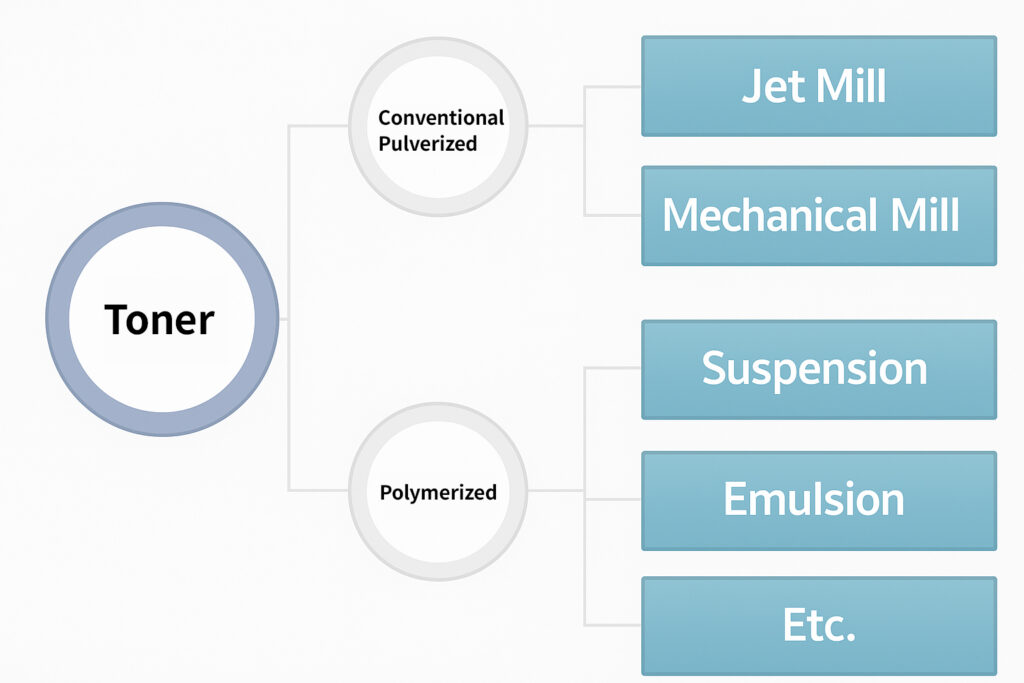
Classification of Toners by
Developing Method

Fundamental Principles of the Electrophotographic Process
The electrophotographic imaging process involves a continuous system of steps: toner charging through corona discharge, creation of an electrostatic latent image via exposure on a charged photoconductor, development of the visible image with toner, image transfer onto paper, and heat-pressure fusion for permanent fixation.


① Charging
A uniform electrostatic charge is applied to
the surface of the photoreceptor.
The charge neutralization process eliminates residual potentials from previous imaging steps, thereby optimizing subsequent printing quality.
This process utilizes either contact-based Primary Charge Rollers (PCR) or non-contact corotron systems, depending on the specific application.
② Exposing
The photoreceptor is selectively exposed to
laser light to form an electrostatic image.
The desired image is projected onto a photoconductive drum using LED or laser exposure, creating regions of differing electrical potential. This process results in the formation of an electrostatic latent image that serves as the basis for printing.
③ Developing
Toner particles adhere to the electrostatic
image, rendering it visible.
Inside the developing unit, toner particles acquire an electric charge through triboelectric interaction with carrier particles or charging members such as blades. The charged toner is then transferred from the developing roller to the electrostatic latent image on the photoconductor, a process driven by the electrostatic potential difference. At this stage, the latent image on the photoconductor is developed into a visible image.
④ Transferring
The toner image is transferred from the
photoconductor to the paper substrate.
The toner image developed on the photoconductor is transferred onto paper by means of electrostatic force, resulting in the visible image being formed on the paper.
⑤ Fusing
Heat and pressure are applied to fuse the
toner onto the paper surface permanently.
The toner transferred onto paper is typically fused using a combination of heat and pressure. As part of energy-saving initiatives, there is growing demand for toners that can achieve fixation at lower temperatures.
⑥ Cleaning
Any residual toner left on the
photoconductor is thoroughly cleaned.
In the cleaning process, any residual toner remaining on the photoconductor after image transfer is removed—typically using a rubber blade or similar device. Complete removal is essential, as any leftover toner can adversely affect subsequent images.
Black Printer

Color Printer

Black Copier

Color Copier

Company
Products
Sustainability
Media Center

Company Name: COSMO AM&T Co., Ltd. | Business Registration Number: 137-81-01917 | CEO: Dong-Hwan Hong
Head Office: 36, Chungjuhosu-ro, Chungju-si, Chungcheongbuk-do, Republic of Korea
Tel: +82-43-850-1114 | Fax: +82-43-851-9298 | COPYRIGHT © 2025 COSMO AM&T. ALL RIGHTS RESERVED.

Company Name: COSMO AM&T Co., Ltd.
Business Registration Number: 137-81-01917 | CEO : Dong-Hwan Hong
Head Office : 36, Chungjuhosu-ro, Chungju-si, Chungcheongbuk-do, Republic of Korea
Tel: +82-43-850-1114 | Fax: +82-43-851-9298
COPYRIGHT © 2025 COSMO AM&T. ALL RIGHTS RESERVED.

Company Name: COSMO AM&T Co., Ltd.
Business Registration Number: 137-81-01917
CEO: Dong-Hwan Hong
Head Office: 36, Chungjuhosu-ro, Chungju-si
Chungcheongbuk-do, Republic of Korea
Tel: +82-43-850-1114 | Fax: +82-43-851-9298
COPYRIGHT © 2025 COSMO AM&T. ALL RIGHTS RESERVED.
COPYRIGHT(C) 2025 COSMOAMT ALL RIGHTS RESERVED.



No.1 Fiberglass Door
Manufacturer in Korea
DoorCo Korea Co.,LTD
TEL : +82-43-930-0200
FAX : +82-43-930-0201